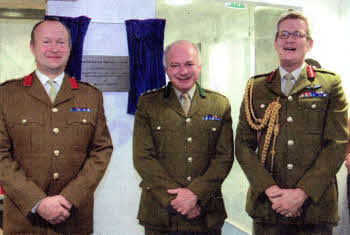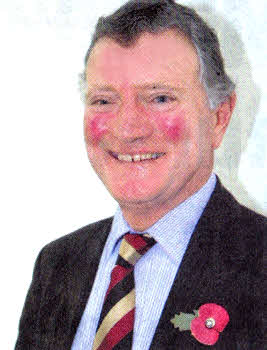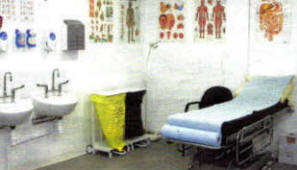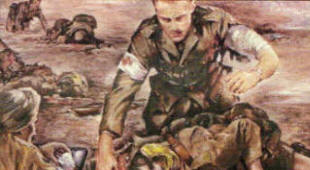
New army medical centre
named in honour of Lisburn war hero and doctor
by STACEY HEANEY
 |
 |
| L-R Colonel N C Smith, Col W C Black and DGAMS Maj Gen M J Von Bertele OBE QHP at the official opening of the new Sinton Medical and Dental Centre. Image by Mike O'Neill. | Mr Neil Watson, grandson of Brigadier Sinton VC, at the opening of the new Sinton Medical and Dental centre. Image by Mike O'Neill. |
THE grandson of one of Lisburn's bravest war heroes who was also a doctor has said his grandfather would have been "proud" of a new medical and dental centre at Thiepval Barracks which has been named in his honour.
The Sinton Medical and Dental Centre was officially opened on Tuesday by Major General MJ von Bertele in honour of the local man who was awarded the Victoria Cross for his heroic actions during World War One, when he attended the wounded despite having been shot through both arms and the side himself.
It replaces the centre destroyed in an IRA bomb in 1996. On October 7 a car bomb went off at 3:35 in the afternoon. It was followed by a second around ten minutes later close to the base's medical facilities where victims were gathering. Warrant Officer James Bradwell (43) was killed and 21 soldiers and 10 civilians were injured.
The new centre houses a casualty room, treatment rooms, an area to check fitness levels and carry out essential tests, such as hearing tests on soldiers who have returned from Afghanistan, and a changing and shower area.
It is home to three nurses, a pharmacy technician and three doctors - all under the watch of the Senior Medical Officer, whilst the dental practice is also equipped with the essential tools of the trade.
 |
 |
| One of the treatment rooms in the new Sinton Medical and Dental Centre, which was officially opened on Tuesday. Image by Mike O'Neill. | A painting of Brigadier Sinton tending to the wounded at the Orah Ruins, Mesopotamia (Iraq) in 1916. The painting, along with Brigadier Sinton's Victoria Cross is on display in the Army Medical Services Museum in Aldershot. England. |
Brigadier Sinton's grandson Neil Watson said he was "absolutely thrilled" the new centre would carry his grandfather's name.
Mr Watson commented: "My grandfather was a very modest man but he would have been proud."
He added that his family felt "very honoured": "My mother is still alive. Although she is in a home now she is delighted by this."
Brigadier John Alexander Sinton, who was born in British Columbia, Canada in 1884, was educated at Nicholson Memorial School, Lisburn, now Christ Church Parochial Hall, from the age of nine until he was fifteen years old and the Inst before he going on to achieve medical degrees from Queen's College, Belfast, the University of Cambridge and the University of Liverpool.
His family, including parents Walter Lyon and Isabella Sinton (nee Pringle), were a family of Quakers involved in the linen industry. Having joined the Indian Medical Service in 1911, the then Captain Sinton was award the VC following his actions on January 21 1916 at the Orah Ruins, Mesopotamia, now Iraq, when he attended to the wounded, whilst wounded himself, and when under very heavy fire.
The citation to his VC reads: "Although shot through both arms and through the side, he refused to go to hospital, and remained as long as daylight lasted, attending to his duties under very heavy fire. In three previous actions Captain Sinton displayed the utmost bravery."
Military historian Richard Doherty described Brigadier Sinton as a "remarkable combination of soldier and doctor", adding that he was "unique" being the only person to be a VC recipient and a Fellow of the Royal Society, which made him "a tremendous individual".
Brigadier Sinton was also awarded the Russian Order of St George, the Russian equivalent of the VC, and he was Mentioned in Dispatches, a military award for gallantry or otherwise commendable service, six times. Specialising as a Malariologist, Brigadier Sinton transferred from the military to the civil branch of the Indian Medical Service in 1921, where he continued to serve until 1936.
He married Eadith Seymour Steuart-Martin on September 19 1923, and having retired, he was recalled as an IMS reservist on the outbreak of World War Two and commanded a hospital in India.
Despite having again retired, he was appointed consultant malariologist to the east African force and later to Middle East command, retiring with the honorary rank of brigadier in August 1943. He then worked as consultant malariologist to the War Office, travelling widely to Assam, Australia, Burma, Ceylon, India, New Guinea, and the Solomon Islands, where his expertise in malaria was invaluable. Further military decorations resulted from this period, after which he returned to Northern Ireland and retired to Cookstown. He was elected Fellow of the Royal Society in 1946.
Brigadier Sinton died at his home at Slaghtfreedan Lodge, Cookstown, Co. Tyrone, on March 25 1956 and was buried with full military honours at Claggan Presbyterian cemetery in Cookstown.
stacey.heaney@ulsterstar.co.uk
Ulster Star
30/10/2009
